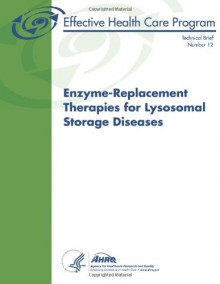Enzyme-Replacement Therapies for Lysosomal Storage Diseases: Technical Brief Number 12
Lysosomes are generally spherical, subcellular organelles bounded by a single layer membrane within eukaryotic cells. They are ubiquitous structures that contain an array of glycoprotein acid hydrolase enzymes, all of which are synthesized in the endoplasmic reticulum and modified in the Golgi...
show more
Lysosomes are generally spherical, subcellular organelles bounded by a single layer membrane within eukaryotic cells. They are ubiquitous structures that contain an array of glycoprotein acid hydrolase enzymes, all of which are synthesized in the endoplasmic reticulum and modified in the Golgi apparatus. Lysosomal enzymes catabolize all major classes of biological macromolecules such as proteins, nucleic acids, glycosphingolipids, mucopolysaccharides, and glycogen, as well as sequestered bacteria, viruses, and other foreign substances that are taken up by phagocytosis into white blood cells and macrophages. Lysosomes are also responsible for autophagy, the gradual turnover of each cell’s own components as they age and become obsolescent. They may be considered the main site of intracellular digestion and housekeeping. Lysosomal storage diseases (LSDs) comprise a group of unique monogenic autosomal or Xlinked diseases that occur secondary to genetic defects (e.g., single nucleotide substitutions, frameshift mutations, gene deletions) that cause total deficiency or reduced activity of specific native enzymes within the lysosomes. This allows macromolecular compounds that are normally enzymatically catabolized to accumulate within these organelles, expanding them and causing progressive damage in connective tissue, skeletal structure, various organs, and, in some cases, the central nervous system. The damage caused by substrate accumulation results in physical deterioration, functional impairment, and, potentially, death. Some fifty different LSDs have been identified, broadly divided into categories that are defined by accumulation of a specific macromolecule. Although each LSD is individually somewhat rare, as a group they have an incidence of about 1 per 7,000 to 8,000 live births, with regional and genetic population variations. LSDs may be variably expressed as infantile, juvenile, or adult forms. In adult-onset diseases, the pathogenesis is usually slower than in the infantile or juvenile forms, and may include peripheral and CNS symptoms. By contrast, infantile and juvenile forms often involve progressive central nervous system involvement in addition to peripheral symptoms. LSDs also often exhibit significant heterogeneity in ultimate expression, with early or late presentation of symptomatic pathology that may be a function of mutation type and residual enzyme levels. Although specific mutations or types of mutations may be connected to discrete disease effects, genotype-phenotype correlations are often not strong. The objective of this Technical Brief is to provide an overview of FDA-approved ERT for the treatment of six lysosomal storage diseases (shown in Table 1). Four Guiding Questions (following) address the clinical indications for each ERT, potential benefits and harms associated with each ERT product, and dosing and administration details of each ERT. An electronic scan of the literature provides a picture of published evidence on clinical use of these agents for each LSD. This Technical Brief also discusses unresolved or controversial issues surrounding the use of ERT to treat lysosomal storage diseases, based on the literature and information obtained through semi-structured, one-on-one telephone interviews with Key Informants. Guiding Questions include: 1. What FDA-approved enzyme-replacement therapy (ERT) products are available for lysosomal storage diseases (LSDs)? 2. What is the context in which each FDA-approved ERT product is used? 3. What published and unpublished studies have reported on the use and safety of this intervention? 4. What are key unresolved or controversial issues with ERT in LSDs?
show less

